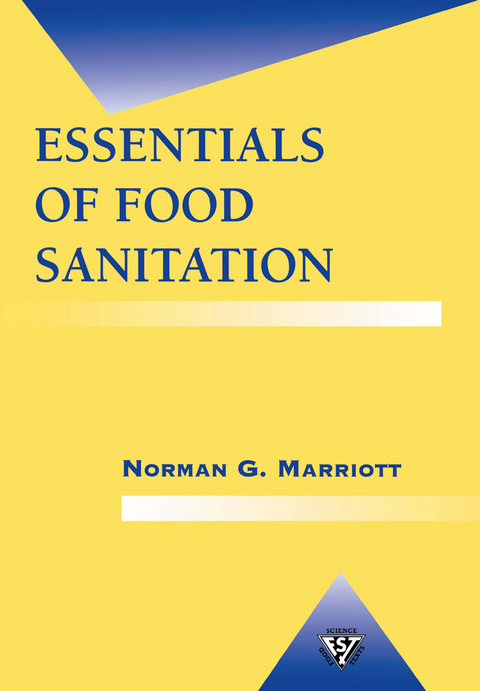
Essentials of Food Sanitation
Chapman and Hall (Verlag)
978-0-412-08011-1 (ISBN)
1 Sanitation: definitions and regulations.- Importance of sanitation.- Definition and application to food industry and foodservice.- Current regulations.- Voluntary sanitation programs.- Establishing sanitary practice.- 2 Microorganisms.- Common microorganisms.- Growth phases of microorganisms.- What causes microbes to grow?.- How food is spoiled.- Foodborne illness.- Destroying microbes.- Inhibiting growth of microbes.- Tests to detect and count microbes.- 3 Sources of food contamination.- The chain of infection.- How foods become contaminated.- Other sources of contamination.- How to prevent and control contamination of foods.- 4 Personal hygiene and food handling.- Personal hygiene.- Hygienic food handling.- 5 Cleaning compounds.- Types of soil.- How soil is attached.- How cleaning compounds work.- Types of cleaning compounds.- Additives to cleaning compounds.- Scouring compounds.- Choosing a cleaning compound.- Handling and storing cleaning compounds.- Chemical contamination of food.- 6 Sanitizing methods.- Heat.- Radiation.- Chemicals.- 7 Cleaning and sanitizing systems.- Costs.- Selecting a system.- Cleaning equipment.- Sanitizing equipment.- Lubrication equipment.- 8 Waste disposal.- Strategy for waste disposal.- Solid-waste disposal.- Liquid-waste disposal.- 9 Pest control.- Insects.- Insect destruction.- Rodents.- Birds.- Use of pesticides.- Integrated pest management.- 10 Quality Assurance and Hazard Analysis Critical Control Point (HACCP).- Quality assurance (QA).- Total quality management (TQM) and hazard analysis critical control points (HACCP).- HACCP principles.- Developing and implementing HACCP.- 11 Dairy processing and product sanitation.- Major pathogens.- Plant construction.- Types of soil.- Sanitation management.- Cleaning equipment.- 12 Meat and poultry sanitation.- Common pathogens.- Sanitation management.- Cleaning practices for meat and poultry plants.- Cleaning compounds for meat and poultry plants.- Sanitizers for meat and poultry plants.-Personal hygiene and work habits of employees.- Sanitation procedures.- Troubleshooting tips.- 13 Seafood sanitation.- Sources of seafood contamination.- Sanitation management.- Plant construction.- Recovering by-products.- Voluntary inspection programs.- 14 Fruit and vegetable processing and product sanitation.- Reducing contamination.- Sanitation management.- Plant construction.- Cleaning processing plants.- Cleaners and sanitizers.- Cleaning procedures.- Evaluation.- 15 Beverage plant sanitation.- Focus on yeasts.- Sanitation management.- Nonalcoholic beverage plant sanitation.- Brewery sanitation.- Winery sanitation.- Distillery sanitation.- 16 Low-moisture-food sanitation.- Facility design and construction.- Receiving and storing raw materials.- Cleaning processing plants.- 17 Sanitary food handling in foodservice.- Sanitary procedures for food preparation.- Reducing contamination.- Cleaning and sanitizing.- Sanitation management and training.- 18 Foodservice control points.- Buying ingredients.- Receiving and storing ingredients.- Preparing, serving, and reheating foods.- Facility and equipment design.- 19 Management and sanitation.- Management’s role.- Hiring and training employees.- Total quality management.- Appendices 1. Where to get more information about food safety and sanitation: agencies, associations, and consumer organizations.- 2. About pathogenic microorganisms.- 3. Safe cooking temperatures for meat and poultry.- 4. Cold storage times for meat and poultry.- Answers to study questions.
| Reihe/Serie | Food Science Texts Series |
|---|---|
| Zusatzinfo | 34 Illustrations, black and white; 344 p. 34 illus. |
| Verlagsort | London |
| Sprache | englisch |
| Maße | 178 x 254 mm |
| Themenwelt | Studium ► Querschnittsbereiche ► Prävention / Gesundheitsförderung |
| Technik ► Lebensmitteltechnologie | |
| ISBN-10 | 0-412-08011-7 / 0412080117 |
| ISBN-13 | 978-0-412-08011-1 / 9780412080111 |
| Zustand | Neuware |
| Haben Sie eine Frage zum Produkt? |
aus dem Bereich


